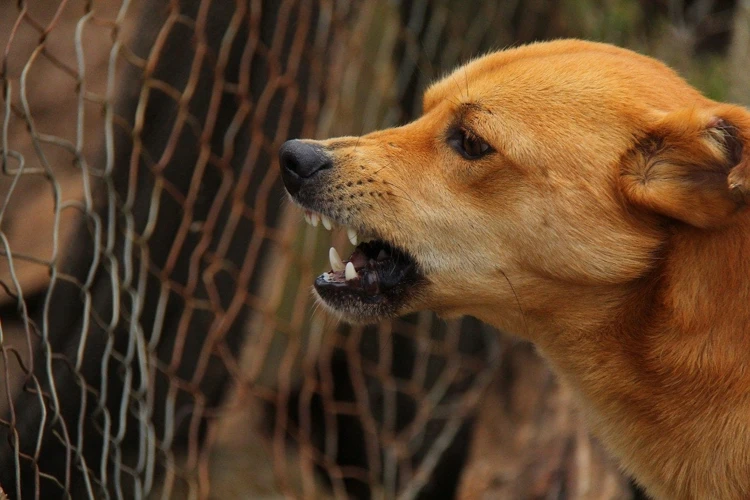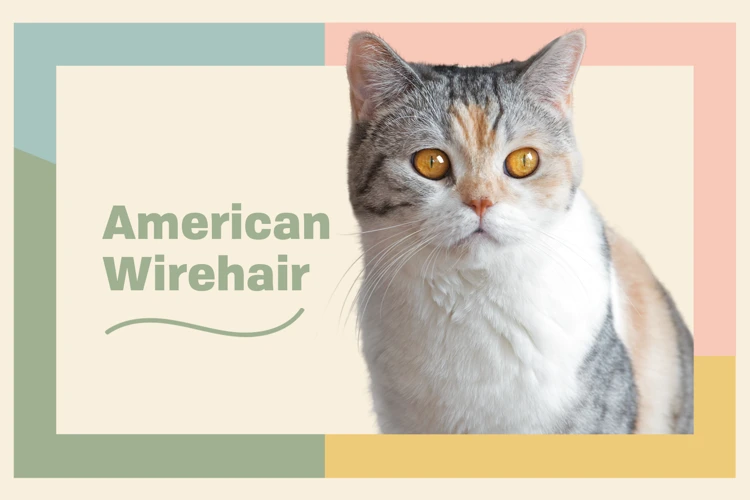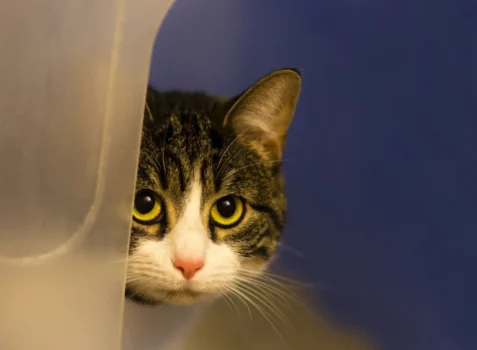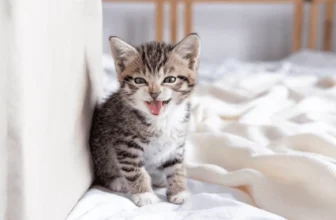As a cat owner, it’s always distressing to see your beloved American Wirehair exhibit fear-related aggression. It can be confusing and overwhelming to try and understand what’s causing this behavior and how you can help your feline companion feel safe and secure again. Fear-related aggression can manifest in a variety of ways, including hissing, growling, scratching, and biting. But there is hope! With patience, love, and the right strategies, you can help your pet overcome their fear-related aggression. In this article, we’ll explore the causes of fear-related aggression, how to recognize it, and most importantly, how to help your American Wirehair feel calm, secure and loved.
Causes of Fear-Related Aggression

As pet owners, we always want our American Wirehair cats to feel safe and comfortable in their environment. However, sometimes they can display fear-related aggression, which can be confusing and concerning. It’s important to understand the root causes of this behavior in order to effectively address it. In this section, we will explore some of the possible reasons why your American Wirehair cat may be exhibiting fear-related aggression. Read on to learn more about possible causes of this behavior and how to recognize them. For more information about aggression in American Wirehair cats, check out our comprehensive guide on American Wirehair cat aggression.
Previous Trauma or Abuse
Cats who have experienced previous trauma or abuse may be more prone to fear-related aggression. This can occur due to the cat associating certain stimuli or situations with the traumatic event, causing them to feel threatened and respond aggressively as a means of self-defense. Common examples of trauma or abuse that can lead to fear-related aggression include physical abuse, abandonment, and neglect.
If you suspect that your American Wirehair cat has experienced previous trauma or abuse, it is important to approach them with patience and understanding. These cats may require more time to build trust and confidence with their owners. Providing a safe and secure environment for them to retreat to when feeling threatened is crucial.
To help your cat overcome fear-related aggression stemming from previous trauma or abuse, consider implementing the following strategies:
- Building a strong relationship with your cat through consistent, positive interactions
- Avoiding any physical punishment or aggression towards your cat as a means of disciplining
- Providing ample hiding places and secure spaces for your cat to retreat to
- Gradually introducing your cat to new stimuli or situations to reinforce positive experiences
It is also important to note that cats who have experienced trauma or abuse may require additional support from a veterinarian or professional. These individuals can provide specific guidance and treatment plans to address your cat’s unique needs.
For more information on aggression in American Wirehair cats and how to manage it, consult with your veterinarian or a feline behavior specialist. Taking proactive steps to address fear-related aggression can help improve your cat’s quality of life and strengthen the bond between you and your furry friend.
Lack of Socialization
Cats that lack socialization with humans and other cats during their crucial developmental period may also exhibit fear-related aggression later in life. This can be a common issue in American Wirehair cats that haven’t been properly socialized from a young age. Without proper socialization, they may perceive people and other felines as threats, and their fear may turn to aggression if they feel cornered or trapped.
What is socialization?
Socialization involves exposing kittens to different stimuli, including human interaction, other animals, and various environments. When done during the first seven weeks of life, it can shape a cat’s personality and social behavior positively. Proper socialization teaches kittens to be well-adjusted and confident, making them better adjusted to living with other cats or humans. It can also prevent the development of fear-related aggression later in life.
Signs of Fear Aggression due to Lack of Socialization:
Some of the signs that your American Wirehair cat is suffering from fear-related aggression due to a lack of socialization include:
- Hissing or growling when approached
- Biting or scratching
- Attempting to flee or hide
- Excessive shyness or hiding
How to Help an American Wirehair Cat with Lack of Socialization:
To help your cat overcome fear-related aggression due to a lack of socialization, you can try the following:
| Techniques | Description |
| Training Techniques | Training can help your American Wirehair cat adapt to new environments, people, and other animals. The gradual acclimation can provide calming cues and soon it begins to feel more comfortable and relaxed around people and other animals. |
| Interactive Playtime | Interactive play is an excellent way to transition your cat that fears social contact into the company of other cats or people. The playtime can provide confidence-boosting interactions with humans and other animals and create new happy associations with them. |
| Gradual Acclimation to New Experiences | A gradual exposure to new socialization experiences will help your American Wirehair cat build trust and confidence. The method involves controlled introductions to new situations over several short sessions, allowing the cat to become more comfortable over time. |
| Enrichment and Territory Expansion | Providing varied stimuli and territory expansion also strengthens the cat’s confidence. An excellent way to achieve this is by offering multiple hiding areas, high resting places, and scratching objects, which will help the cat feel safe and in control of its environment. |
Remember, be patient when working with a timid or frightened American Wirehair cat. The key to success is a calm and patient approach and seeking help when needed from a professional cat behaviorist.
Preventative Measures
Preventative measures are vital to maintaining your American Wirehair cat’s healthy social behavior. Here are a few crucial things you can do:
- Regular veterinary care is essential to prevent medical or physical discomfort that can cause or exacerbate fear aggression.
- Making sure your home environment is consistent and predictable reduces stress and anxiety in timid cats.
- Encourage positive interactions among pets. Confidence and positive associations with other cats can go a long way in preventing aggressive behavior.
With the right tools and techniques, you can help your American Wirehair cat overcome fear-related aggression and enjoy a calm and rewarding life with humans and other cats.
Sudden Changes in Environment
American Wirehair Cats are highly sensitive animals and sudden changes in their environment can trigger fear-related aggression. Examples of sudden changes in environment that can cause fear-related aggression include:
| Sudden Changes in Environment |
|---|
| A move to a new home or apartment |
| The introduction of a new pet into the household |
| A change in the household routine |
| Renovations or construction in the home |
If your American Wirehair Cat is exhibiting fear-related aggression after a sudden change in their environment, it is important to take steps to help them feel secure and comfortable. Some strategies to help with this include gradual exposure therapy, positive reinforcement training, and establishing consistency in their routine.
It is also important to provide your cat with a safe and secure space where they can retreat when they feel threatened or overwhelmed. This can be as simple as a corner with a cozy bed and some toys, or a separate room where they can have some privacy. By giving your cat a sense of control over their environment, you can help ease their anxiety and prevent fear-related aggression.
Pain or Illness
It’s important to recognize that pain or illness can be a cause of fear-related aggression in American Wirehair cats. When a cat is feeling unwell, they may become defensive, agitated, and lash out as a way to protect themselves. It’s crucial to rule out any underlying medical conditions before addressing a cat’s fear-related aggression.
Below is an HTML table outlining the different signs of pain and illness to look out for in your American Wirehair cat:
| Signs of Pain and Illness in Cats |
|---|
| Decreased activity |
| Decreased appetite or water intake |
| Changes in litter box habits |
| Excessive grooming or lack of grooming |
| Limping or reluctance to move |
| Vocalizing more than usual |
| Visible wounds or injuries |
| Withdrawn behavior or aggression |
If you notice any of these signs, it’s important to take your cat to the veterinarian for a thorough examination. Once any underlying medical conditions have been addressed, you can begin to work on addressing your cat’s fear-related aggression.
Recognizing Fear-Related Aggression

Recognizing fear-related aggression in your American Wirehair cat can be difficult, especially since it may not always be obvious. Fear-related aggression may manifest itself in a number of ways, including hissing, growling, or swatting. Sometimes your cat might even attempt to flee from the situation or hide.
One key factor to pay attention to is your cat’s body language. Cats that are exhibiting fear-related aggression may have their ears flattened against their head and their tail held low, or they may be standing with their hair raised and their body in a defensive posture.
Another indicator could be the situation in which the aggression occurs. If your cat only exhibits aggressive behavior in specific situations, such as when encountering strangers or other pets, this could signal fear-related aggression. Other potential symptoms to watch for include dilated pupils, excessive grooming, and excessive scratching or biting at themselves.
It’s important to take note of any signs of aggression your cat displays, as fear-related aggression can escalate quickly if not addressed properly. It’s essential to work on addressing the underlying fear and anxiety causing the aggression, rather than just trying to suppress the aggressive behavior without addressing the root cause.
Strategies for Helping Your Cat

As a pet owner, dealing with fear-related aggression in your American Wirehair Cat can be overwhelming and stressful. However, there are several strategies you can use to help your furry friend overcome this behavior. It’s important to remember that every cat is unique, so finding the right approach may take some trial and error. In this section, we’ll discuss some effective ways to build trust and confidence in your cat, including gradual exposure therapy and positive reinforcement training. Let’s dive in and explore these strategies further.
Building Trust and Confidence
One effective strategy for helping your American Wirehair Cat overcome fear-related aggression is to build trust and confidence with your pet. This process may take some time, but it can ultimately help your cat to feel more secure and confident in their surroundings.
To build trust and confidence with your cat, consider the following techniques:
| Technique | Description |
|---|---|
| Giving Treats | Offering your cat treats can help them associate you with positive experiences and build positive associations with humans. |
| Playing Games | Interactive playtime with toys can help your cat build confidence and trust with you. This can also be a fun bonding activity for you and your pet. |
| Providing Safe Spaces | Creating safe spaces for your cat, such as a designated hiding spot or a covered cat bed, can help your pet feel more secure and in control of their surroundings. |
| Offering Comfort | When your cat is feeling anxious or scared, offering comfort and reassurance, such as gentle petting or soothing words, can help them feel more secure and build trust with you. |
Remember to always approach your cat calmly and with patience, avoiding sudden movements or loud noises that may startle them. With consistent efforts to build trust and confidence, your American Wirehair Cat can feel more comfortable and secure in their environment.
Gradual Exposure Therapy
One effective strategy for helping your American Wirehair cat overcome fear-related aggression is gradual exposure therapy. This method involves gradually introducing your cat to the stimuli that trigger their fear or aggression, in a controlled and safe environment.
Here is a table of the key steps involved in implementing gradual exposure therapy:
| Step | Description |
|---|---|
| Step 1: | Identify the specific trigger(s) for your cat’s fear or aggression |
| Step 2: | Develop a plan for exposing your cat to the trigger(s) gradually, in a controlled environment |
| Step 3: | Start with a low level of exposure, such as showing your cat a picture or recording of the trigger |
| Step 4: | Slowly increase the level of exposure over time, always paying attention to your cat’s body language and behavior |
| Step 5: | Reward your cat with treats or positive reinforcement for staying calm and relaxed during exposure sessions |
| Step 6: | Continuously monitor your cat’s progress and adjust your plan as needed |
It’s important to note that gradual exposure therapy may not work for every cat. If your cat’s fear-related aggression is severe or if they have a history of trauma or abuse, consulting with a veterinarian or professional behaviorist is strongly recommended. They may recommend alternative strategies or therapies to help your cat overcome their fear and aggression.
Positive Reinforcement Training
Positive reinforcement training is a highly effective method for helping American Wirehair cats overcome fear-related aggression. This type of training focuses on rewarding good behavior instead of punishing bad behavior. The idea is to encourage the cat to repeat the desired behavior by rewarding it with something it enjoys, such as a treat or playtime.
The first step in positive reinforcement training is to identify the behavior you want to encourage. For example, if your cat is afraid of strangers, you might want to reward it for staying calm and relaxed when someone new comes to visit.
Once you have identified the desired behavior, you can start rewarding your cat with treats or other incentives. It’s important to be consistent and patient, as positive reinforcement training can take time to produce results.
Here are some tips for using positive reinforcement training with your American Wirehair cat:
| Tip | Description |
|---|---|
| Be consistent | Make sure you reward your cat every time it exhibits the desired behavior. Consistency is key to making positive reinforcement training work. |
| Use high-value rewards | Choose rewards that your cat loves, such as a favorite treat or a favorite toy. This will make the training more effective. |
| Start small | Begin with simple behaviors and work your way up to more complex ones. This will help your cat build confidence and learn step-by-step. |
| Be patient | Positive reinforcement training takes time and patience. Don’t expect overnight results, but with consistency and perseverance, your cat can learn to overcome its fear-related aggression. |
Positive reinforcement training is just one of many strategies you can use to help your American Wirehair cat overcome fear-related aggression. By combining multiple strategies and seeking professional help when necessary, you can create a safe and loving environment for your furry friend.
Consulting with a Veterinarian or Professional
If your American Wirehair cat continues to display fear-related aggression even after trying the aforementioned strategies, it may be time to consider consulting with a veterinarian or professional. This is especially important if you suspect that your cat’s behavior may be due to an underlying health issue or if their aggression is causing harm to themselves or others.
Here are some steps to take when consulting with a veterinarian or professional:
- Do your research and find a professional who specializes in cat behavior and is familiar with fear-related aggression.
- Be prepared to provide your cat’s medical history, including any previous experiences with aggression.
- Describe your cat’s behavior in detail, including triggers for aggression and any previous attempts to modify their behavior.
- Allow the professional to observe your cat’s behavior firsthand, possibly in a controlled environment.
- Discuss possible treatment options and create a plan together with the professional. This may involve medication or additional training techniques.
- Follow through with the recommended treatment plan and continue to communicate with the professional to track progress and make adjustments as necessary.
Remember, consulting with a veterinarian or professional does not mean you have failed as a cat parent. It simply means you are committed to helping your cat overcome their fear-related aggression and providing them with the best possible care.
Preventing Fear-Related Aggression
As a cat owner, it is important to recognize the potential for fear-related aggression in your fur baby. Whether your American Wirehair cat has a history of trauma or is simply prone to anxiety, there are steps you can take to prevent such behavior from escalating. By incorporating a few simple practices into your routine and providing your feline friend with a safe and consistent environment, you can help ensure a happy, well-adjusted pet. Here are some tips for preventing fear-related aggression in your American Wirehair.
Proper Socialization
For American Wirehair cats, proper socialization is crucial in preventing fear-related aggression. Socialization is the process of exposing cats to a variety of experiences, people, and other animals, in a positive and controlled manner, so that they learn to feel comfortable and confident in different situations.
The Benefits of Proper Socialization
When an American Wirehair cat is properly socialized, it develops positive associations with new experiences, which can help prevent fear-related aggression later in life. Proper socialization helps cats understand that new experiences are not threatening, so they are less likely to react aggressively when faced with new situations.
Socialization also helps cats learn how to interact with people and other animals in a positive way. This helps them develop social skills, which can reduce the likelihood of aggression or fearful behavior when they encounter new animals or people in the future.
When to Begin Socialization
The best time to begin socializing an American Wirehair kitten is between 2 and 12 weeks of age. During this time, kittens are much more receptive to new experiences and are more likely to adapt to new situations without fear.
How to Socialize Your American Wirehair
The key to proper socialization is to expose the cat to a wide variety of experiences and stimuli in a controlled and positive way. For example, you can gradually introduce your cat to new people or other animals by starting with short, supervised visits, followed by positive reinforcement such as treats or praise.
Another effective socialization strategy is to provide plenty of interactive toys and games to help your cat develop coordination and confidence. Interactive play can also help cats bond with people and other animals, which can reduce the likelihood of fear-related aggression.
Here is a table summarizing the important points:
| Key Point | Details |
|---|---|
| Benefits of Socialization | Develops positive associations with new experiences, learns how to interact with people and other animals in a positive way |
| When to Begin Socialization | Between 2 and 12 weeks of age |
| How to Socialize Your Cat | Expose to a wide variety of experiences and stimuli in a controlled and positive way, provide interactive toys and games, start with short, supervised visits followed by positive reinforcement |
Proper socialization is critical for preventing fear-related aggression in American Wirehair cats. By providing a wide variety of positive experiences and interactions, you can help your cat develop confidence and social skills, which can reduce the likelihood of aggression or fearful behavior later in life.
Consistency in Routine
Keeping a consistent routine can be extremely beneficial in preventing fear-related aggression in American Wirehair cats. Consistency is key when it comes to minimizing stress and anxiety in cats. Make sure to establish a daily routine that includes feeding, playtime, and sleeping. Keep the feeding schedule consistent, as cats can become anxious when their meal times vary. Additionally, playtime is essential for keeping your cat active and mentally stimulated, and can help alleviate any built-up stress or anxiety.
It’s also important to keep your cat’s environment consistent. Avoid moving around furniture or changing the location of their belongings too frequently. This can be especially important if your cat has already exhibited fear-related aggression, as sudden changes in their environment can trigger anxiety and aggression.
When it comes to litter boxes, make sure to keep them in the same location and clean them regularly. Cats are notoriously clean animals and a dirty litter box can cause anxiety and stress.
Finally, try to keep your own routine consistent as well. If you have any changes in your schedule that will affect your cat, such as travel, try to prepare them in advance and stick to a routine as much as possible. This will help minimize any stress or anxiety your cat may feel due to changes in their routine.
In summary, consistency in routine is important for preventing fear-related aggression in American Wirehair cats. Establish a daily routine that includes feeding, playtime, and sleeping. Keep their environment consistent, particularly with litter box placement and cleanliness. Finally, try to keep your own routine consistent as well, and prepare your cat for any changes in advance.
Regular Veterinary Care
Regular veterinary care is an essential aspect of ensuring your American Wirehair cat’s physical health and well-being. By scheduling routine check-ups, your cat can receive preventative care, as well as early detection and treatment of any illnesses or medical conditions.
Preventative care: Regular visits to the veterinarian can help prevent health issues before they arise. Your cat will receive vaccinations and heartworm prevention medication as recommended by your veterinarian. Additionally, the vet can perform wellness exams to check for any underlying conditions or signs of illness that may be developing.
Early detection and treatment: When your cat visits the veterinarian regularly, any changes in their health can be detected early, making it easier to treat and manage the illness. This includes detecting any dental problems such as tartar buildup or gum disease. The veterinarian will also check for any lumps or bumps that may be cancerous or require further examination.
Diet and nutrition: Your veterinarian can provide advice on the best diet and nutrition plan for your American Wirehair cat, taking into account their age, weight, and any medical conditions. This can help ensure that your cat is receiving all of the essential nutrients they need to maintain their overall health and well-being.
Behavioral issues: If you notice any behavioral changes or other issues with your cat’s behavior, your veterinarian can provide advice and assistance. This includes guidance on litter box issues, aggression, and other behavior problems that may arise.
By scheduling regular veterinary care for your American Wirehair cat, you can help ensure that they stay physically healthy and happy. A healthy cat is a happy cat, and a happy cat makes for a happy owner.
Conclusion
As a responsible pet owner, it’s essential to understand the underlying causes of fear-related aggression in American Wirehair cats. Whether it’s due to previous trauma, lack of socialization, sudden changes in their environment, or pain and illness, recognizing the signs of fear-related aggression is crucial in helping your cat overcome this behavior.
Fortunately, there are various strategies that cat owners can implement to help their pets feel more comfortable and build trust and confidence. Gradual exposure therapy, positive reinforcement training, and consulting with a veterinarian or a professional behaviorist can all be effective in treating fear-related aggression.
Prevention is always better than cure, and proper socialization, consistency in routine, and regular veterinary care are three key ways to prevent fear-related aggression from developing in the first place. By providing a safe and secure environment and regularly attending to your cat’s physical and emotional needs, you’ll be helping your pet feel more relaxed and confident in their surroundings.
In conclusion, fear-related aggression in American Wirehair cats can be a challenging and sometimes frustrating behavior to deal with as a pet owner. However, with patience, empathy, and the appropriate training and support, it’s possible to help your cat overcome their fears and become a happy and balanced companion animal. Remember, each cat is unique, and what works for one might not work for another, so be open to experimentation and working closely with professionals in the field to find the best approach for your cat.
Frequently Asked Questions
What is fear-related aggression in cats?
Fear-related aggression in cats is a behavior where a cat responds aggressively, often with biting or scratching, to a situation or stimuli that triggers fear or anxiety.
What are some common causes of fear-related aggression in American Wirehair cats?
The most common causes of fear-related aggression in American Wirehair cats are previous trauma or abuse, lack of socialization, sudden changes in environment, and pain or illness.
How can I recognize fear-related aggression in my American Wirehair cat?
You can recognize fear-related aggression in your American Wirehair cat by observing their body language, such as flattened ears, dilated pupils, and a puffed-up tail. They may also hiss, growl, or lunge towards the source of their fear.
What are some strategies for helping my American Wirehair cat overcome fear-related aggression?
Some strategies for helping your American Wirehair cat overcome fear-related aggression include building trust and confidence, gradual exposure therapy, positive reinforcement training, and consulting with a veterinarian or professional.
What is gradual exposure therapy and how can it help my cat?
Gradual exposure therapy is a technique where your cat is exposed gradually and at a controlled pace to the situation or stimuli that causes their fear-related aggression. This helps your cat learn to tolerate and eventually overcome their fear.
What are some ways I can prevent fear-related aggression in my American Wirehair cat?
You can prevent fear-related aggression in your American Wirehair cat by providing proper socialization, consistency in routine, and regular veterinary care.
What is positive reinforcement training and how can it benefit my cat?
Positive reinforcement training is a technique where your cat is rewarded with treats or praise for exhibiting desired behavior. This can help motivate your cat to learn new behaviors and increase their confidence.
What should I do if my American Wirehair cat shows signs of fear-related aggression?
If your American Wirehair cat shows signs of fear-related aggression, you should consult with a veterinarian or a professional animal behaviorist to help diagnose the underlying causes and create a plan for treatment.
Can fear-related aggression in American Wirehair cats be cured?
Fear-related aggression in American Wirehair cats can be managed and reduced with proper treatment and management strategies, but it may not be completely cured.
Is fear-related aggression in American Wirehair cats dangerous?
Fear-related aggression in American Wirehair cats can be dangerous, especially if left untreated. It can result in injuries to both the cat and their owner, and can also lead to a decline in the cat’s quality of life.







